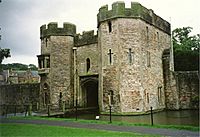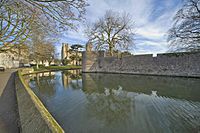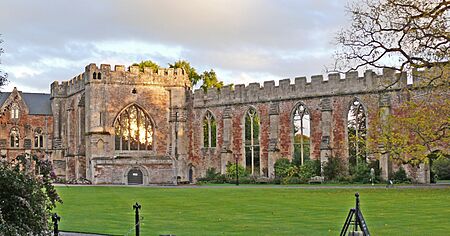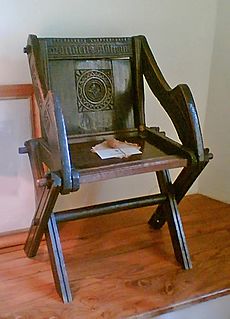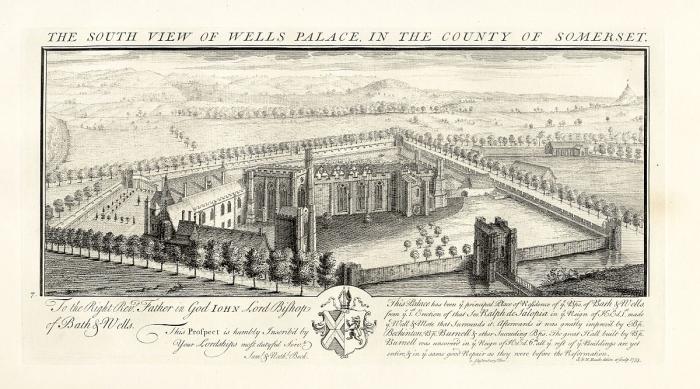Bishop's Palace, Wells facts for kids
Quick facts for kids Bishop's Palace |
|
|---|---|
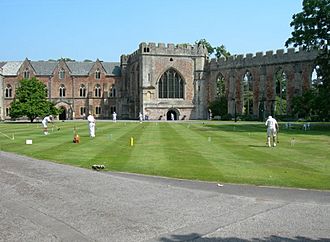
Croquet on the lawn of The Bishop’s Palace, in front of the chapel
|
|
| General information | |
| Town or city | Wells |
| Country | England |
| Coordinates | 51°12′34″N 2°38′33″W / 51.20944°N 2.64250°W |
| Construction started | c. 1210 |
| Client | Jocelin of Wells |
The Bishop's Palace is where the bishop of Bath and Wells lives in Wells, England. It's right next to Wells Cathedral. Bishops have lived here since the early 1200s. It's a very important historic building, officially called a Grade I listed building.
Building started around 1210 by bishops Jocelin of Wells and Reginald Fitz Jocelin. The chapel and great hall were added later by Bishop Robert Burnell between 1275 and 1292. The strong walls, gatehouse, and moat were built in the 1300s by Bishop Ralph of Shrewsbury. Bishop Thomas Beckington added the Bishop’s House in the 1400s. The great hall later became old and was partly taken down around 1830.
The palace was once surrounded by a medieval deer park. When the walls were built, streams were moved to create the moat. This moat acted like a water storage area. In the 1820s, Bishop George Henry Law planted gardens inside the walls. He also made a reflecting pond near the springs. Parts of the palace are still used by the current bishop. However, much of the palace is now open to the public and is a popular place for visitors.
Contents
History of the Bishop's Palace
Building the palace began around 1210 by Bishop Jocelin of Wells. Most of it was built from 1230 onwards. Bishop Jocelin also helped build the cathedral. He was responsible for the Bishop's Palace and other important buildings. These included a school for singers, a grammar school, and a place for travelers.
The chapel and great hall were built between 1275 and 1292 for Bishop Robert Burnell. The windows had beautiful stone designs. Stone carvings on the ceiling show oak leaves and the Green Man. The building is a great example of the Early English style.
In the 1300s, Bishop Ralph of Shrewsbury continued the building work. He had some disagreements with the people of Wells. Because of this, he built strong, 5 metres (16 ft) high walls around his palace. He also added a moat and a drawbridge. The three-story gatehouse, built in 1341, has a bridge over the moat. The entrance was protected by a heavy gate and a portcullis. There were also openings to pour hot liquids on attackers.
The drawbridge was still used in 1831. It was closed when news came of an attack on another bishop's palace. This happened during the Bristol riots. These riots were about a new law to give more power to big cities. But there were no riots in Wells. The moat was filled by springs in the grounds. This water also powered watermills in the town.
The north wing, now called the Bishop's House, was added in the 1400s. Bishop Thomas Beckington built it. It was changed again in the 1700s and 1810. It was later fixed up and had an upper floor added between 1846 and 1854. After the Dissolution of the Monasteries in 1548, Bishop Barlow sold the palace. But it was returned to the church in 1552.
In the 1550s, Bishop Barlow sold the lead from the Great Hall's roof. The hall was mostly taken down around 1830 by Bishop George Henry Law. He made it a "more picturesque ruin" by removing walls. He then planted gardens where the hall once stood. The palace was used by soldiers during the English Civil War. It was also a prison for rebels after the Battle of Sedgemoor.
Bishop Richard Kidder died during the Great Storm of 1703. Two chimneys fell on him and his wife while they slept. A central porch was added around 1824. In the 1840s and 1850s, Benjamin Ferrey restored the palace. He added an upper story and fixed the chapel. He used stained glass from old French churches.
In 1953, the palace was named a Grade I listed building. In 2008, a famous poet wrote a poem about a war veteran. It was first read at the Bishop's Palace.
The Glastonbury Chair
One of only two remaining Glastonbury chairs is at the palace. It was made in Britain around 1504. It was for a monk named John Arthur Thorne. He was the treasurer at Glastonbury Abbey. Arthur perished in 1539 during the Dissolution of the Monasteries. The last Abbot of Glastonbury sat on a similar chair during his trial at the Bishop's Palace. Other chairs like this, old and new, can also be seen.
Current Use of the Palace
The palace now belongs to the Church Commissioners. It is managed by The Palace Trust. The main palace is open to visitors. You can see the old vaulted undercroft, the chapel, and a long gallery. The Bishop’s House is still used as a home and offices. There is a café with views of the Croquet Lawn. The palace is used for weddings, conferences, and meetings. The croquet lawn is used regularly.
The palace was used for filming parts of the 2007 movie Hot Fuzz. It was also used in the 2016 film The Huntsman. Other shows filmed here in 2015-2016 included Galavant, Terry and Mason’s Great Food Trip, Escape to the Country, and Holiday of My Lifetime. It was also featured in The White Princess.
In December 2013, it was announced that Peter Hancock would become Bishop of Bath and Wells in 2014. It was first said he would work, but not live, at the Palace. Later, it was announced he would live in the Palace. This decision was made after a committee decided another house was not suitable. The palace was also used as a French prison in the BBC drama Poldark, series 3.
Palace Architecture
Bishop's Eye Gateway
The Bishop's Palace is part of the Liberty of St Andrew. This area includes the cathedral, the palace, and other clergy buildings. You can enter the palace grounds from the market place. You go through an archway called The Bishop's Eye. Bishop Beckington built it around 1450. It is a three-story building made of stone with a copper roof. It is a Grade I listed building. The Bishop's Eye is similar to the Penniless Porch. This porch is another gateway into the Cathedral from the market place.
The Bishop's Palace Building
The palace building has two floors and seven sections. Three of these sections have pointed roofs called gables. There is an attic under these roofs. The inside has a hall, a private room called a solar, and a gallery. It has stone floors and a fireplace from the 1500s.
To the right is a chapel from the late 1200s. It is built of local stone. The remains of the 13th-century Great Hall include a north wall. There are also some column bases. These show it was a large hall with five sections. It had crenellations (notches on the walls) and tall windows.
Bishop's House
The Bishop's House has two narrow parts with a small courtyard. The front of the building has crenellated walls. The rooms inside have been changed many times. It still has features from the 1400s, like a doorway and oak screens. Some windows have pieces of stained glass from the 1500s.
Palace Grounds and Gardens
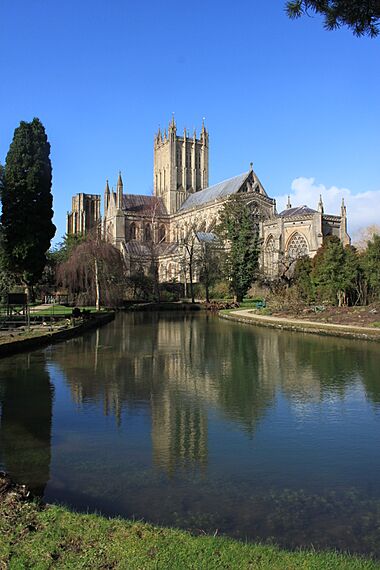
In the 1200s, the palace grounds included a medieval deer park. King John gave Bishop Jocelin permission to create this park in 1207. The palace gardens had orchards, a herb garden, and kitchen gardens. These provided food for the Bishop and his staff.
Today, there are about 14 acres (5.7 ha) of gardens. They include St Andrew's Spring, which gives the city its name. Water flows from this spring into the moat. The moat holds a lot of water. The water comes from the cave system of the Mendip Hills. The Well House was built in 1451 for Bishop Beckington. It provided water to the people of Wells. This small stone building has a hole in the floor to access the well. The gardens are very important, listed as Grade II*.
The grounds also included The Bishop's Barn. This was built in the 1400s to store crops given as tax. The area next to it is now a public park. The barn was made of local stone. Soldiers were kept in the barn during the time of the "Bloody Assizes."
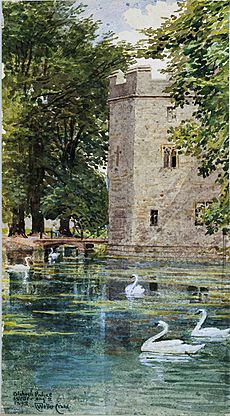
Much of the current garden on the south lawn was created by Bishop George Henry Law in the 1820s. He included the remains of the Great Hall. He also built a raised path along the inside of the wall. Bishop Law also made a grotto. He used it to show fossils from nearby caves. Many trees and shrubs were planted. These included a black walnut, Lebanon cedar, and ginkgo. In the 1830s, Bishop Law created a pool near the springs. On calm days, it reflects the cathedral in the water.
In the outer garden, there is an arboretum. Bishop John Bickersteth planted it in 1977. This was to celebrate Queen Elizabeth II's Silver Jubilee. The mute swans on the moat are famous. They have been taught to ring bells by pulling strings to ask for food. The first swans were trained in the 1870s. Two swans given by Queen Elizabeth II in 2006 still ring for lunch. Caretakers who live in the gatehouse feed them.
Every August bank holiday, the moat hosts the Wells Moat Boat Race. This is a charity raft race. In 2007, the Bishop entered a raft. In 2013, a "tree of heaven" on the south lawn fell down. It had been planted in 1885.
Images for kids


